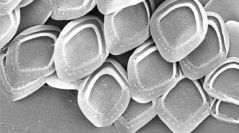

 Cryptogamie, Algologie
38 (4) - Pages 325-347
Cryptogamie, Algologie
38 (4) - Pages 325-347The distributions of scaled chrysophytes in 22 waterbodies from the eastern portion of Newfoundland, Canada, are described relative to environmental gradients. A rich and diverse flora of scaled chrysophytes was recorded that included 47 species from six genera, Mallomonas (n = 29), Synura (n = 7), Neotessella (n = 1), Chrysosphaerella (n = 2), Spiniferomonas (n = 7) and Paraphysomonas (n = 1). Combined with previous works, 57 species of scaled chrysophytes are now known from Newfoundland. On average, 15 species were recorded from each site, and 34 of the taxa were found in more than 10% of the sites. The most widely distributed species were Mallomonas duerrschmidtiae, M. galeiformis, Synura echinulata, S. sphagnicola, and S. petersenii sensu lato, each found in over 75% of the study sites. Seven additional species were found in over 50% of the localities indicating the rich diversity of the flora. One site is of particular significance as it represents the type locality for three species, including Mallomonas newfoundlandicus sp. nov. described in this communication, and represents the northern-most site harboring the marker taxon, M. binocularis. Expanded descriptions of M. maculata and Spiniferomonas abei are given, and evidence is presented that Synura synuroidea represents two distinct species. Overall, the flora reflects habitats that are acidic, dilute and contain moderate to high concentrations of humic substances. Since many of the species are diagnostic bioindicators, these organisms would provide a valuable resource for future paleolimnological studies aimed at understanding impacts from environmental stressors on Newfoundland lakes.